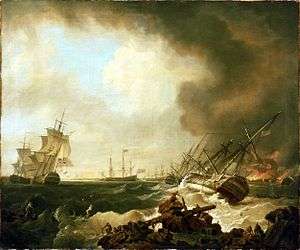HMS Essex (1679)
HMS Essex was a 70-gun third rate ship of the line of the Royal Navy, launched at Blackwall Yard in 1679.[1]
 Battle of Quiberon Bay: the Day After (Richard Wright, 1760) Essex is the more distant ship on its side, to the left of HMS Resolution | |
| History | |
|---|---|
| Name: | HMS Essex |
| Builder: | Johnson, Blackwall Yard |
| Launched: | 1679 |
| Fate: | Wrecked, 21 October 1759 |
| General characteristics as built[1] | |
| Class and type: | 70-gun third rate ship of the line |
| Tons burthen: | 1072 tons BM |
| Length: | 150 ft 2 in (45.8 m) (gundeck) |
| Beam: | 40 ft (12.2 m) |
| Depth of hold: | 16 ft 9.5 in (5.1 m) |
| Propulsion: | Sails |
| Sail plan: | Full rigged ship |
| Armament: | 70 guns of various weights of shot |
| General characteristics after 1700 rebuild[2] | |
| Class and type: | 70-gun third rate ship of the line |
| Tons burthen: | 1090 tons BM |
| Length: | 150 ft 4 in (45.8 m) (gundeck) |
| Beam: | 40 ft 7.5 in (12.4 m) |
| Depth of hold: | 16 ft 6 in (5.0 m) |
| Propulsion: | Sails |
| Sail plan: | Full rigged ship |
| Armament: | 70 guns of various weights of shot |
| General characteristics after 1713 rebuild | |
| Propulsion: | Sails |
| Sail plan: | Full rigged ship |
| General characteristics after 1740 rebuild[3] | |
| Class and type: | 1733 proposals 70-gun third rate ship of the line |
| Tons burthen: | 1225 |
| Length: | 151 ft (46.0 m) (gundeck) |
| Beam: | 43 ft 5 in (13.2 m) |
| Depth of hold: | 17 ft 9 in (5.4 m) |
| Propulsion: | Sails |
| Sail plan: | Full rigged ship |
| Armament: |
|
She was rebuilt at Rotherhithe in 1700, retaining her 70-gun armament. She underwent a second rebuild in 1713,[2] and on 20 May 1736 she was ordered to be taken to pieces and rebuilt at Woolwich as a 70-gun third rate to the 1733 proposals of the 1719 Establishment. She was relaunched on 21 February 1740.[3]
Essex was wrecked on the Four Shoal in 1759, eighty years after she was first launched, while chasing the French flagship Soleil Royal after the Battle of Quiberon Bay.[4]
Notes
- Lavery, Ships of the Line vol.1, p162.
- Lavery, Ships of the Line vol.1, p166.
- Lavery, Ships of the Line vol.1, p170.
- Corbett, Julian S. (1907), England In The Seven Years War vol II, Longmans Green, p. 68
gollark: ++help
gollark: I know, this is hard.
gollark: Hmm, should I just put everything in docker, or...?
gollark: Okay, that's it, I clearly badly need to rework my server setup.
gollark: I really broke something.
References
- Lavery, Brian (2003) The Ship of the Line - Volume 1: The development of the battlefleet 1650-1850. Conway Maritime Press. ISBN 0-85177-252-8.
This article is issued from Wikipedia. The text is licensed under Creative Commons - Attribution - Sharealike. Additional terms may apply for the media files.